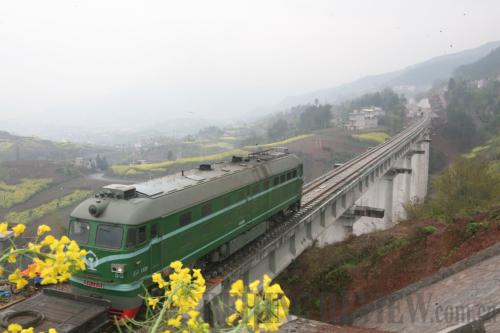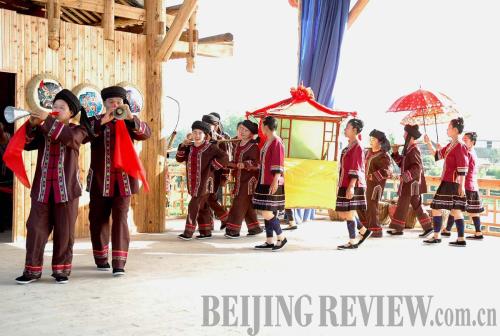|
 |
|
COMES TO MOUNTAIN: Hubei Province has increased spending on infrastructure. Yichang-Wanzhou Railways now go through mountainous areas of the Enshi Tujia and Miao Autonomous Prefecture (TAN BING TRAIN) |
Dazhuanguai is a village in Longfeng Town of Enshi Tujia and Miao Autonomous Prefecture, central China's Hubei Province. Soil in the village cannot absorb water therefore none can be drawn from wells. Over the years, villagers here used water from pools, roofs or natural puddles. The quality of water cannot be ensured, and moreover, in the drought season, villagers had no water at all.
In July 2008 the village received funds of 1.5 million yuan ($220,588) from local government to build 1.5 km of water pipelines, diverting water from a neighboring village. It also built 42 water cellars. Among the 2,304 villagers in 635 families, 1,555 people in 401 families now have clean and stable water, said Li Zaiyin, Secretary of the Longfeng Town Committee of the Communist Party of China (CPC).
Helping themselves
 |
|
DANCING FOR A LIVING: People in the Dong Village Tourism Area of Bajiao Dong Town, the Enshi Tujia and Miao Autonomous Prefecture, present Dong songs and dance for the tourists (TAN BING) |
Among all the 60 million people of Hubei, 2.83 million, or 4.68 percent, are of ethnic minorities. Most of these people, mainly from Tujia, Miao and Dong, live in Enshi Tujia and Miao Autonomous Prefecture (which consists of eight counties and county-level cities), as well as Changyang Tujia Autonomous County and Wufeng Tujia Autonomous County of Yichang City.
In recent years, Hubei has achieved rapid economic growth. Figures released by the Hubei Statistics Bureau showed GDP of the province totaled 923.07 billion yuan ($136.35 billion) in 2007, growing 14.5 percent from the year before.
However, because the areas inhabited by ethnic minorities are in regions of Wuling Mountain, infrastructure has been historically underdeveloped, restricting economic progress. In 2004-07, the average annual GDP growth of these areas was just 6.7 percent, much lower than the national and provincial levels.
Instead of asking the Central Government for aid to accelerate development of the areas inhabited by ethnic minorities, Hubei has explored a new way of offering aid through local governments. In August 2007 Hubei decided to launch a campaign to help people of these areas raise living standards. For each county or city, six departments of the provincial government, universities or big state-owned enterprises are designated to offer aid and a provincial leader is designated to coordinate the work.
Statistics released by the Ethnic and Religious Affairs Committee of Hubei Province (HERAC) say, since the campaign was launched, aid providers have implemented 619 projects, offering a total of 3.16 billion yuan ($466.77 million), which has driven up investment of 10.6 billion yuan ($1.57 billion). Of the total, 202 projects are on infrastructure, with an investment of 1.68 billion yuan ($248.15 million); 142 projects are on industrial development, with an investment of 934 million yuan ($137.96 million); 169 projects are on social development, with an investment of 303 million yuan ($44.76 million); 106 projects are on other purposes, with an investment of 241 million yuan ($35.6 million).
All these efforts have helped improve economies of the areas inhabited by ethnic minorities in Hubei. HERAC figures, in 2008, show the GDP in these areas increased 19.4 percent and the fiscal revenue increased 30 percent. In 2009, though influenced by the global financial crisis, the GDP in these areas still increased 16.7 percent to 37.2 billion yuan ($5.49 billion) and the fiscal revenue increased 16.5 percent to 5.28 billion yuan ($779.91 million).
"Where the sun shines, there are still places that fail to absorb sunshine," said Yang Tianran, head of Enshi Tujia and Miao Autonomous Prefecture. "The aid campaign launched by the provincial government is to enable these places to see sunshine."
Tapping potential
Feng Xingchao, 32, has operated a hotel and restaurant out of his home in Fengxiangpo, Dong Village Tourism Area of Bajiao Dong Town, Enshi for three years. During his childhood, his family was very poor. Transportation in the village was terrible, with only dirt roads connecting the villages.
In 1997, Feng went to southeast China's Fujian Province and worked on a food factory production line. He earned just 800-900 yuan ($118-133) a month and almost no money was left after paying for living expenses.
|
